
The Real Story Behind Your Heel Pain: What 15 Years of Treating Plantar Fasciitis Has Taught Me
Dr. Rob Letizia PT, DPTShare
Last Tuesday, a woman limped into my clinic practically in tears. "I've tried everything on YouTube," she said. "Ice, stretching, those stupid tennis balls. Nothing works. What's wrong with me?"
Sound familiar?
I see this frustration every single day. And honestly? It breaks my heart. Because after 15 years of treating foot pain, I can tell you that most people are treating the wrong problem entirely.
Here's what I wish every person with heel pain knew: that stabbing pain in your heel might not even be about your heel. I know that sounds crazy, but stick with me.
Why Everything You've Tried Hasn't Worked
Three months ago, I had a patient, let's call him Mike, who'd been suffering for two years. TWO YEARS. He'd bought custom orthotics, done every calf stretch known to mankind, even got steroid injections. Still couldn't walk his dog without wincing.
Turns out his real problem? His big toe couldn't bend properly. Fixed that in three sessions.
This happens more than you'd think. We get so focused on where it hurts that we miss what's actually causing the pain. It's like trying to fix a leaky roof by putting buckets on the floor, you're dealing with the symptom, not the source.
The Four Culprits I See Most Often (And How to Test for Them Yourself)
1. Your Calves Are Tighter Than You Think
I can't tell you how many patients insist their calves are fine because they stretch them every morning. Then I have them try what we call the "honest squat test."
Try this right now: Squat down like you're sitting in a chair, but keep going until your butt nearly touches your heels. Keep your feet flat on the ground and your back straight. Can't do it without falling backward? Your calves are probably part of the problem.
When your calves are tight, they yank on your heel bone all day long. Every step becomes a tug-of-war between your calf and your foot. Guess who usually loses?
What actually works: Forget the quick 30-second stretches. Your calves have been tight for months or years, they need consistent attention. Find a curb or step, hang your heel off the edge, and lean into it. But here's the key: do this for 2-3 minutes at a time, multiple times throughout your day. Your calf needs time to actually lengthen, not just get a quick hello.
2. Your Feet Have Gone Soft
This one's tough to hear, but our modern lifestyle is killing our feet. We stuff them in shoes from morning to night, walk on flat surfaces, and wonder why they can't handle the demands we place on them.
Think about it, when's the last time your feet actually had to work? Like, really grip and support and balance?
My favorite test: Stand barefoot and try to pick up a towel with your toes. Sounds simple, right? Most of my patients can barely scrunch the fabric. That tells me everything I need to know about their foot strength.
The fix that actually sticks: Start going barefoot more. I know, I know, easier said than done. But even 10 minutes a day makes a difference. When you're watching TV, ditch the slippers. When you're cooking dinner, lose the shoes. Your feet need to remember how to be feet again.
Also try this: while you're standing around (waiting for coffee to brew, brushing your teeth), practice lifting your arch without rolling your ankle in or out. It feels weird at first, but you're basically giving your foot muscles a mini-workout.
3. Your Big Toe Is Stuck
This is the one that surprises people most. Your big toe needs to bend back about 10-15 degrees when you walk, otherwise, your whole stride gets messed up. I see so many people with perfectly flexible ankles and tight hamstrings who've never even thought about their toe mobility.
Quick check: Sit down and grab your big toe. Can you pull it back toward your shin easily? Does it feel tight or uncomfortable? If your toe can't move, your foot can't function properly during push-off, and that stress goes straight to your heel.
What I tell my patients: A few times a day, just grab that big toe and gently pull it back. Hold it for 10-15 seconds. Don't force it, coax it. You're not trying to make it crack or pop, just reminding it how to move again.
4. Old Scar Tissue That Won't Let Go
If you've been dealing with this pain for more than a few months, there's probably some scar tissue that's formed in your plantar fascia. It feels like a little knot or pebble right near your heel, especially first thing in the morning.
Here's where those tennis balls and frozen water bottles actually make sense, but most people are using them wrong.
The right way: Sit in a chair (don't stand on the ball, that's too much pressure). Roll gently for 30-60 seconds, focusing on that tender spot. It should feel like a "good hurt," not excruciating pain. You're trying to encourage healing, not create more damage.
And please, PLEASE give this time. Scar tissue doesn't disappear overnight. We're talking weeks to months of consistent work. I know that's not what you want to hear, but it's the truth.
What I Really Want You to Know
After all these years, here's what I've learned: your body is incredibly smart. That pain isn't random, it's information. It's telling you that something in the chain isn't working right.
Maybe it's tight calves from sitting at a desk all day. Maybe it's weak feet from a lifetime in supportive shoes. Maybe it's a toe that got stiff after an old injury you forgot about. The point is, there's usually a reason, and once you find it, everything starts to make sense.
I had a patient last month, a runner who'd been sidelined for eight months. Tried everything: physical therapy, injections, even considered surgery. Turned out her hip flexors were so tight from her desk job that her whole leg mechanics were off. Spent six weeks working on her hips, and now she's back to running pain-free.
Your situation might be different, but the principle is the same: look beyond where it hurts.
A Reality Check on Healing
I'm going to be straight with you about timelines because I'm tired of seeing people get discouraged when they're not "fixed" in two weeks.
Real healing, the kind that lasts, takes time. If you've had pain for months, expect the recovery to take months too. Your body didn't break overnight, and it won't heal overnight either.
Some days will be better than others. Some weeks you'll feel like you're going backward. That's normal. Healing isn't linear, and anyone who tells you otherwise is selling something.
When to Get Help
Look, I'm all for trying things at home first, but there are times when you need professional eyes on the problem. If you've been dealing with severe pain for more than a few weeks, if simple walking is becoming difficult, or if you're starting to limp and change how you move, please see someone who knows feet.
We're not just being greedy or trying to make money (though we do have to eat). Sometimes the problem is more complex than what you can figure out on your own, and catching it early can save you months of frustration.
The Bottom Line
Your heel pain probably isn't just about your heel. It might be your calves, your foot strength, your toe mobility, or old scar tissue that needs attention. Maybe it's all of the above.
The key is being honest about what's really going on with your body and giving any treatment approach enough time to actually work. And please, for the love of all that's holy, stop jumping from one miracle cure to the next every two weeks.
Your feet have carried you through life, they deserve better than quick fixes and false promises. They deserve the real solution, even if it takes longer than you'd like.
Trust the process. Your future self will thank you.
Have questions about your specific situation? Drop me a comment below. I read every single one and try to respond when I can. And if this helped you understand your heel pain better, share it with someone else who's struggling. Sometimes the best medicine is just knowing you're not alone in this.



